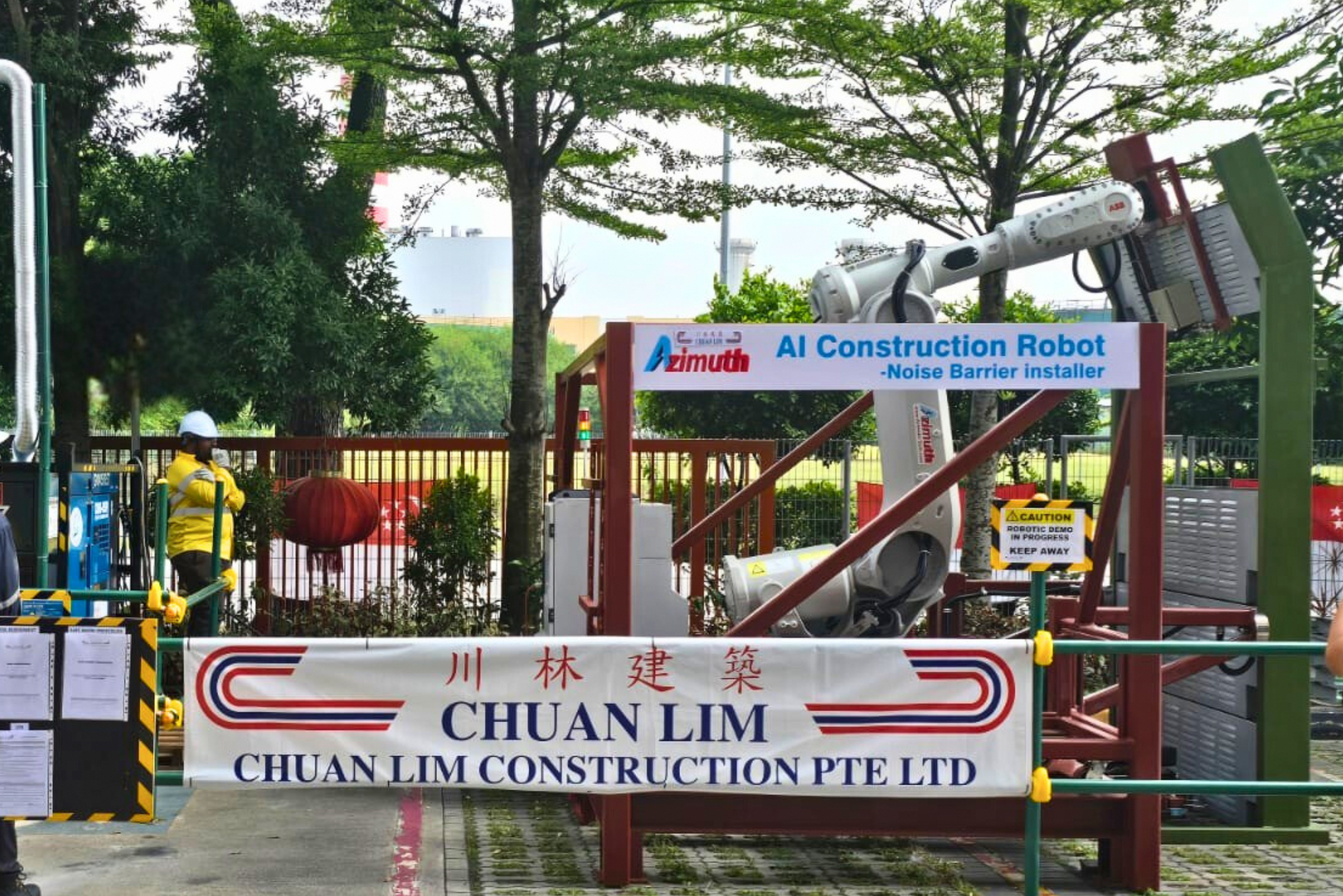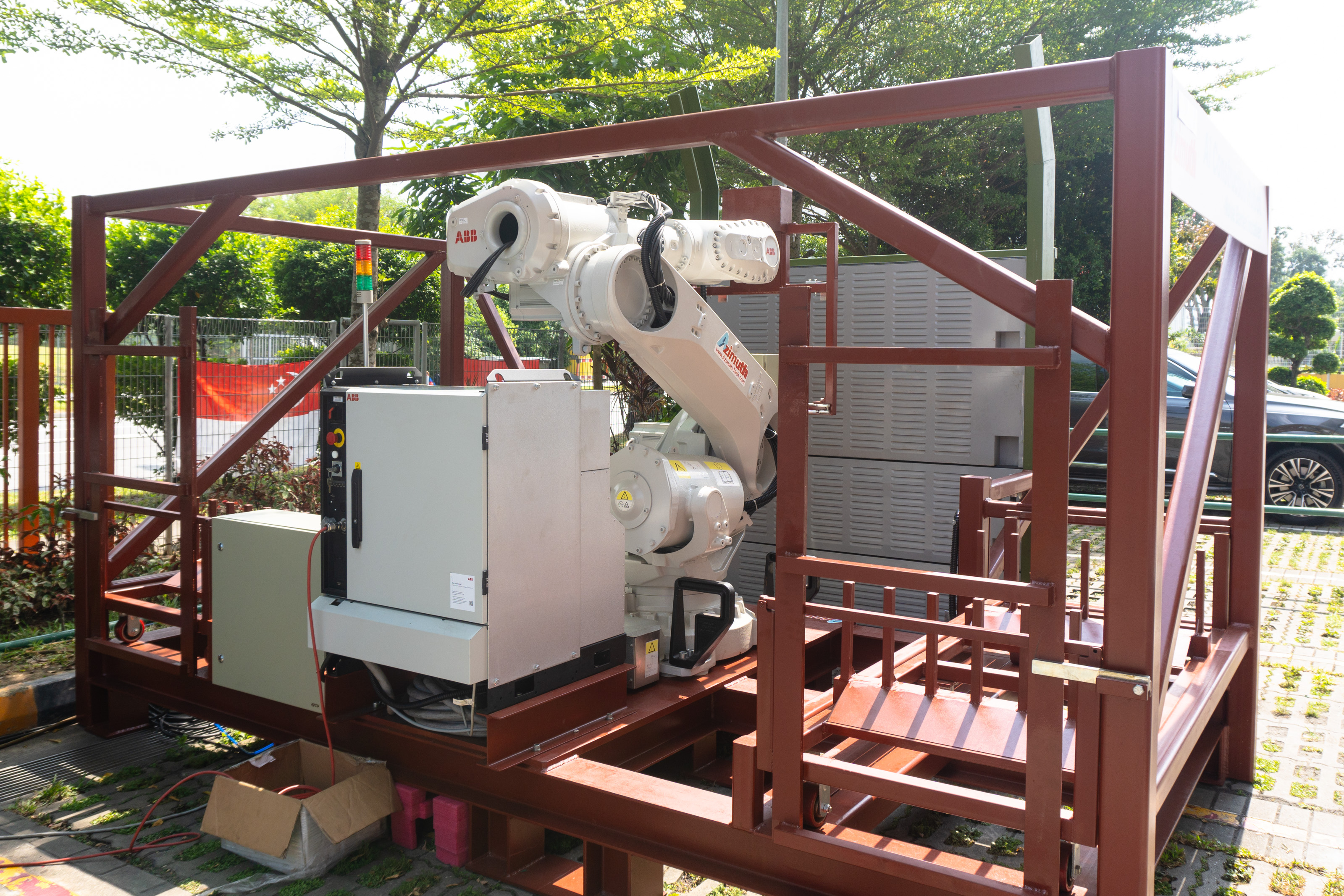Noise barrier panels are commonly installed at construction sites to minimize noise pollution and protect surrounding areas from excessive sound levels. While they primarily serve a functional purpose, there panels are a permanent feature and form an integral part of the overall structure. Their installation is labour-intensive, time-consuming, and physically demanding than that of any other building/ construction component.
Typically requiring at least two workers on a boom lift and another two on the ground, a single set – made up of seven horizontal panels between two vertical support guide poles– takes roughly 30 minutes of manual installation.
Not only do workers have to work at great heights, they also frequently lift heavy loads. While machinery is used to lift the 200kg columns, workers are still involved in positioning and securing them. Additionally, they manually handle the 18 kg panels, further increasing safety risks.
An opportunity for change is here! Through the Built Environment Accelerate-to-Market Programme (BEAMP), Chuan Lim Construction (CLC) and Azimuth Technologies have collaborated to improve this process, through the development of a robotic arm that makes it easier and safer for panel installation.
After initial testing, their innovative solution will be piloted at the Land Transport Authority’s (LTA) Jurong Regional Line project in March 2025, with subsequent plans for wider adoption.
Finding a good match
Having spent a decade working with noise barrier panels, CLC a leading local civil engineering contractor with over 30 years of experience - is no stranger to the tedious installation process.
Using a boom lift, workers must alternate between the ground and the installation site, retrieving one panel at a time before installing it. “It’s very repetitive,” said CLC Director Bijay Joseph. “(But we thought) anything that was repetitive and had fixed constraints could surely be automated.”
Searching for a solution, CLC participated in BEAMP in 2022. Led by the Building and Construction Authority, JTC Corporation, and Enterprise Singapore, the initiative was launched in 2019 and aims to build a vibrant innovation ecosystem to solve the BE sector’s challenges.
Within three months, the BEAMP network sourced for and matched a viable partner: Azimuth Technologies, a local material handling solutions provider that has developed innovative engineering solutions across the oil and gas industry since 2005.
Mr Joseph said: “BEAMP provided a platform for different collaborators to join the BE industry. Had we been on our own, we would have never known about Azimuth.”
Leveraging CLC’s vast knowledge of the installation process and Azimuth’s automation expertise, they quickly began conceptualising and building the robotic arm.
Similar to an arcade’s claw machine, the arm needed three-dimensional movement capabilities: forward, backward, left, right, up, and down. It would also need to be engineered to withstand heavy noise barrier panels.
In addition to mobility and strength, accuracy is also a key factor, such as identifying where the panels should be fixed between guide poles.

Robotic arm installing panels between guide poles
In summary, the process could then be developed into a concise series of steps, all while working at height:
- Scan the position of two noise barrier guide poles
- Align itself between the two guide poles
- Extend down to pick up a panel and carry it
- Secure the panel in its designated position
The next automation challenge
Although the robotic arm performed well in indoor tests, it soon became clear that working outdoors brought a new set of challenges that were overlooked in the initial design
“Imagine looking directly into the sun. You’ll have to close your eyes immediately,” said Mr Joseph. Likewise, the sun’s glare made it impossible for the robotic arm to accurately install the noise barrier panels at certain times of the day, especially when the sun is in the direction of the camera.
As a result, the LIDAR – Light Detection and Ranging – system was introduced by Azimuth. Unlike a camera, it uses pulse laser beams to determine object positions, capturing precise shape and distance data feedback to the robot.
This technology allowed the robotic arm to work effectively at any time of the day – avoiding environment challenges and productivity lapses. The robotic arm can also be operated under wet weather conditions, which would otherwise pose safety risks for workers.
 Completed noise barrier wall just under 15 minutes
Completed noise barrier wall just under 15 minutes
It is also expected to reduce the time required to install a single set of noise barrier panels: from 30 minutes to just 15 minutes, using half the manpower required.
In March 2025, the robotic arm will undergo live testing at the Jurong Regional Line project. If successful, it will be deployed across multiple construction sites throughout Singapore.
For CLC and Azimuth, this development is just the beginning. Mr Joseph noted: “The next step is to look at what else can be automated, which will probably be the installation of the guide poles.”
The weight of these noise barrier guide poles still far exceeds what the current robotic arm is designed to handle, so there is potential for further development. In the meantime, workers are still required for manual installation of these guide poles.
“There is not much automation done (in the BE industry),” noted Mr Joseph. “We want to be one of the companies doing more automation work, where we can reduce the manpower needed while improving safety, efficiency, and productivity.” Inspired by CLC and Azimuth’s spirit of innovation?
Join us as a Challenge Statement Owner to discover and develop innovative solutions through the BEAMP programme!